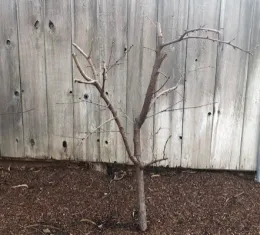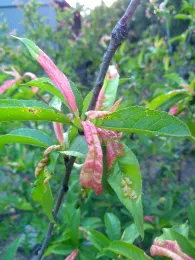
Why spray for peach leaf curl disease?
Right now, the fungus that causes leaf curl is present on your trees. Once spring arrives, its spores “move” via water droplets splashed onto developing leaves. When the environment is right, these spores invade newly developing leaves, growing in between leaf cells and causing distortion of cells.
Symptoms of peach leaf curl disease include puckering leaves that curl and turn a reddish color. Often the entire first set of leaves may drop off. When new leaves begin to grow, these leaves are also infested. Twigs and shoots distort and often die. Fruit is rarely affected. However, left untreated, nectarine and peach trees begin to decline and fruit production is substantially reduced.
Often when gardeners see symptoms of leaf curl disease on their tree, they are tempted to pull off the affected leaves, thinking this will help. Unfortunately, there is little to do at this point to control the disease.
Prevention

Using Pesticides
Insects, diseases, and weeds are pests, and products used to kill them are called pesticides. Whether a product is organic or not, it can still have an impact on you and/or the environment, so be sure to follow the directions on the product label regarding personal protection, correct mixing, and application. When spraying, make sure to coat the tree until the product is dripping off. Come spring, your peach and nectarine tree trees should leaf out and grow vigorously, followed by a healthy crop of fruit.
Learn more about peach leaf curl by visiting the UC IPM website and reading their Quick Tips on it at http://ipm.ucanr.edu/QT/peachleafcurlcard.html For more detailed information about this disease, read the Pest Notes at http://ipm.ucanr.edu/PMG/PESTNOTES/pn7426.html
Coming Soon
Bare root fruit trees are arriving in nurseries and garden centers. If you are thinking about planting fruit trees but aren't sure what to plant, how to plant, and how to care for them, you'll want to attend our online Bare Root Fruit Tree Planting and Pruning Class on January 25, 2022. More details coming next week.
If you have fruit trees that produce a lot of small fruit, you may be missing an important step in growing fruit trees called "thinning." Next month we'll publish an article on how and when to thin fruit from Ed Perry, retired UCCE Stanislaus County Emeritus Horticulture Advisor.
Anne Schellman is the UCCE Stanislaus County Master Gardener Program Coordinator.

